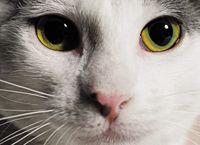Have You Heard? Azotemia in cats? No crystal ball needed (script)
In this study, researchers in the United Kingdom aimed to identify clinical predictors of azotemia development in older healthy cats.
As you know, chronic renal disease is a common condition in geriatric cats. However, by the time it is diagnosed based on elevated plasma creatinine concentrations, a large percentage of functioning kidney mass may have been lost. Researchers in the United Kingdom aimed to identify clinical predictors of azotemia development in older healthy cats. The participating cats were followed for a minimum of one year, and the urine protein-to-creatinine ratio, urine albumin-to-creatinine ratio, and NAG, a urinary enzyme, were evaluated as potential predictors for the development of azotemia.

Ryan McVey/Getty Images
Cats selected for the study were over 9 years of age and thought to be healthy by their owners. Each animal was thoroughly assessed, including a complete history, physical examination, and evaluation of blood and urine samples. Systolic blood pressure measurements and a fundic examination were also used to evaluate each cat. Individuals with systemic hypertension were treated and managed throughout the study. Azotemic and hyperthyroid cats were excluded. The cats were reevaluated at six-month intervals, and, after stabilization, hypertensive cats were evaluated every two months.
Azotemia was diagnosed during the one-year period in more than 30% of the cats participating. No correlation was seen between hypertension and the development of azotemia. However, for those cats that developed azotemia during the study, there were significant increases in plasma creatinine, urea, and phosphate concentrations and decreases in urine specific gravity, body weight, and packed cell volume.
Only proteinuria was consistently associated with the development of azotemia. Interestingly, the urine protein-to-creatinine ratio proved more predictive of azotemia development than the urine albumin-to-creatinine ratio. Those cats that developed azotemia did have a lower urine specific gravity and higher plasma urea and creatinine concentrations at initial evaluation than did those that remained nonazotemic. These initial values were all within the laboratory reference ranges but were significantly different in the two groups. Urine specific gravity also decreased significantly in the cats from the beginning of the study to the development of azotemia. NAG index, one of the variables evaluated, correlated with the urine protein-to-creatinine ratio and was significantly higher in cats that became azotemic. However, it did not prove to be of any additional benefit as a predictor of azotemia.
The researchers concluded that the urine protein-to creatinine ratio is a relatively inexpensive test that requires only a small volume of urine. Monitoring this parameter in conjunction with the plasma creatinine concentration should be part of geriatric screening programs in cats. As cats age, their risk of developing chronic renal failure increases dramatically, and identifying early renal disease may greatly improve the outcome for these patients.
Source: Jepson RE, Brodbelt D, Vallance C, et al. Evaluation of predictors of the development of azotemia in cats. J Vet Intern Med 2009;23(4):806-813.